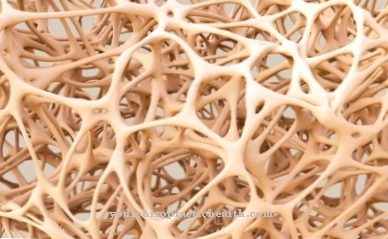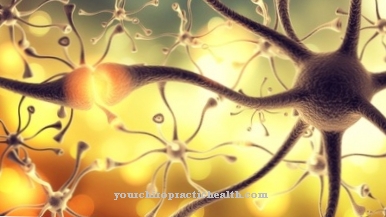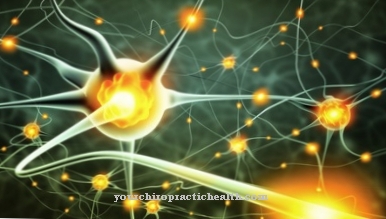The Red cell deformability or flexibility of the red blood cells enables the cells to pass through vessels with different lumens. In addition, erythrocytes change their shape depending on the temperature and flow rate of the blood, which at the same time changes the blood viscosity. Erythrocytes take on an abnormal shape, for example in the context of spherical or sickle cell anemia.
What is erythrocyte deformability?

The red blood cells are also called erythrocytes. The blood cells contain what is known as hemoglobin and are therefore responsible for transporting oxygen in the human body. All body tissues need oxygen for survival. In the area of the lungs, the oxygen passes into the blood, where it is present in unbound and bound form.
There is a binding affinity between oxygen and the hemoglobin of the red blood cells in the lung environment. Bound to the red blood cells, the oxygen moves with the blood to all areas of the human body. Because the environment changes bit by bit on the journey through the body and thus the affinity for binding is reduced, the oxygen is finally released again and taken up by the target tissues.
Red blood cell deformability is one of the most important properties of red blood cells. Because of their flexibility, the erythrocytes are able to to pass the narrowest vessels with the blood and to pass through the smallest capillaries. This phenomenon is particularly relevant for the oxygen supply to all body tissues. The deformability of the erythrocyte membrane enables the red blood cells to pass through the thinnest pores. With every change in shape of the erythrocytes, the flow properties and viscosity of the blood change.
Function & task
The shape of the red blood cells increases their surface area and thus enables an improved gas exchange. Due to their high flexibility, erythrocytes can also migrate through capillaries, which have a smaller diameter than the erythrocytes themselves. Erythrocytes deform or aggregate into rouleaux as part of pseudoagglutination, especially when passing through narrow capillaries.
Under the cell membrane of the red blood cells is a radiating network of structuring and densely arranged filaments, which is known as the erythocyte cytoskeleton and serves to maintain a biconcave shape. Proteins such as spectrin and ankyrin are essential components of cells and contribute to their deformability. Apart from their typically biconcave shape, erythrocytes can take on different shapes thanks to their flexibility.
In their basic form, the red blood cells are called discocytes. The blood cells in flowing blood take on this biconcave disc shape. However, there are several dozen different shape variants. In narrower capillaries, the cells become stomatocytes, for example, and in this context are in a folded cup shape, which makes it easier for them to pass through the narrow-lumen capillaries. Dacryocytes, on the other hand, are tear-shaped and echinocytes are pea-apple-shaped erythrocytes, as found in hypertonic solutions.
The flexibility of the erythrocytes mainly influences the blood viscosity. This means the viscosity of the blood, which combines the material properties with the properties of liquids. Due to its viscosity, the blood shows an adapted flow behavior and does not behave like a Newtonian fluid. Its flow behavior is not proportional, but erratic. In addition to the Fåhraeus-Lindqvist effect, the hematocrit, temperature and flow rate are responsible for this.
In this context, the deformability of erythrocytes, including erythrocyte aggregation, plays a major role. These relationships allow the blood to flow differently in different areas of the body and prevent the cellular blood components from clumping. When the blood flow is slow, erythrocytes cling to one another and form chains. This roll formation or agglomeration is to be understood to a certain extent as physiological.
Illnesses & ailments
In the context of various diseases, the deformability of the erythrocytes is impaired. In still other diseases of the blood system, the red blood cells are in abnormal shape variants. Any abnormality in the shape of the erythrocytes or a reduction in their deformability affects the viscosity of the blood and can accordingly have serious consequences. In the form of so-called acanthocytes, the red blood cells are, for example, prickly cells. This is the shape of erythrocytes, for example, when the phospholipid metabolism is disturbed.
Anulocytes, in turn, are ring-shaped erythrocytes, as they are in high-grade anemia. In the form of fragmentocytes, erythrocytes occur in the phenomenon of intravascular hemolysis. Macrocytes are also a pathological variant of the red blood cells. The erythrocytes are greatly enlarged, as can be the case with folic acid deficiency, for example. In megaloblastic anemia, too, the red blood cells are enlarged. This shape variant is called a megalocyte. The blood components in iron deficiency diseases and hemoglobin deficiency diseases are reduced in size to so-called microcytes.
One of the best-known shape diseases of erythrocytes is spheroid cell anemia, in which the red blood cells appear as small, spherical microspherocytes. Similar to spherical cell anemia, sickle cell anemia is known. The red blood cells change their physiological shape in the context of this disease to the sickle shape, the so-called sickle cell.
In the context of iron deficiency, pernicious anemia and bone marrow lesions, the cells again take on the abnormal shape of poikilocytes. In contrast, the red blood cells are the target cells in the context of thalassemia, toxic anemia or iron deficiency anemia. This shape variant is characterized by the ring-shaped arrangement of the hemoglobin.
Even after mechanical damage, the erythrocytes change their shape to an abnormal shape: the so-called schistocyte. These are deformed erythrocytes that are ultimately only a fragment of the red blood cells. An increased roll formation of the erythrocytes indicates inflammatory phenomena in the context of immune complex diseases.












.jpg)



.jpg)










.jpg)
